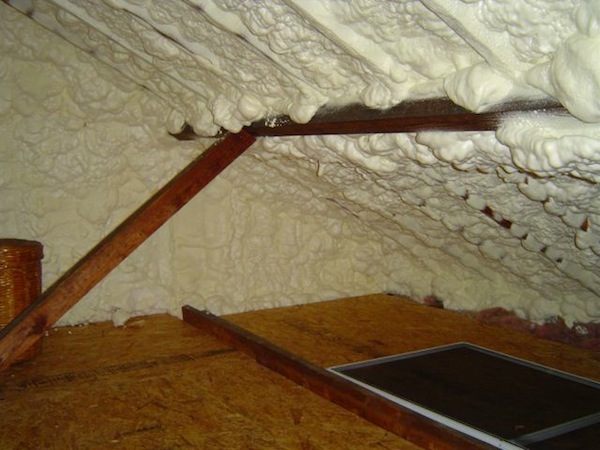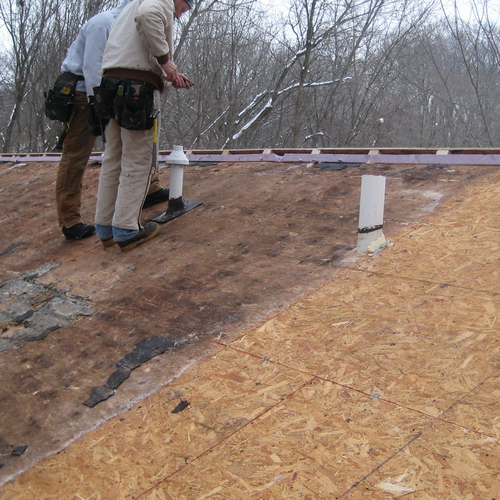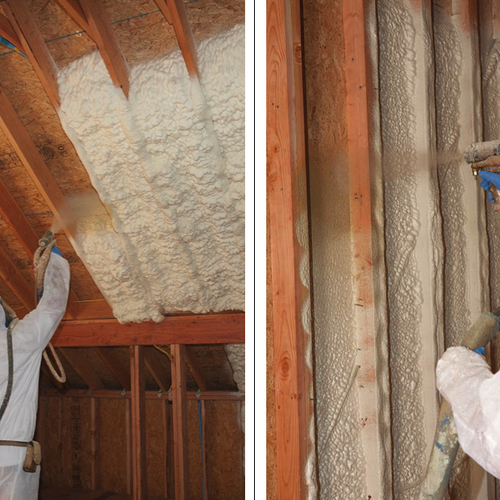Image Credit: Energy Vanguard
Image Credit: Energy Vanguard The Building Science Corporation conducted a study of moisture migration from rooftops into attics in Houston. The researchers looked at several roofing underlayment materials with varying water vapor permeabilities and found that little moisture comes into an attic this way.
Image Credit: Building Science Corporation
Murmurs and hearsay about open-cell spray foam insulation have been gaining traction for a while. It rots roofs, people have told me. Not long ago, someone even told me that in Florida, roofing companies won’t let their workers go up on roofs with open-cell spray foam because the roofs are so spongy, the guys fall right through.
Open-cell spray foam is getting a bad reputation among some people in the construction industry. But is it deserved?
The Energy Nerd stirs up a hornets’ nest
Martin Holladay, the Energy Nerd who muses here at Green Building Advisor, stirred up a hornets’ nest at the beginning of this year by writing an article titled Open-Cell Spray Foam and Damp Roof Sheathing. In it, he reported on two papers presented at the Conference on Thermal Performance of the Exterior Envelopes of Whole Buildings XII last December. Both papers basically came to the same conclusion: “Open-cell spray foam insulation is risky in all climate zones.”
We already know open-cell spray foam, by itself, is risky in cold climates. Moisture from indoors can diffuse through the foam and find the cold roof sheathing, where it accumulates and eventually rots the roof. As a result, in IECC climate zones 5 and higher, building codes require the use of a vapor retarder if you install open-cell spray foam. Many builders in cold climates use closed-cell spray foam instead because of its lower water vapor permeability, which means it doesn’t need the extra step of installing a vapor retarder. But open-cell spray foam with a vapor retarder can work, too, and builders in cold climates have had success with it when they do it right.
Open-cell spray foam has become popular in warmer climates, and this is where the two papers that Holladay reported on could cast the most doubt. In fact, the way Holladay reported the remarks of William Miller, the author who presented one of the papers, it sounds like Miller has no doubt: “The roof sheathing is humid when open-cell spray foam is used,” is how Holladay quoted him.
The simplified version
The two papers were based on computer simulations. In the first paper, Roof and Attic Design Guidelines for New and Retrofit Construction of Homes in Hot and Cold Climates, the authors used HERS BESTEST and AtticSim. In the second paper, A Hygrothermal Risk Analysis Applied to Residential Unvented Attics, the authors used MATLAB and WUFI.
And that’s as far down that path as I’m going. As promised in the title of this section, I’m going to condense this issue, so to speak, down to its essence. If you’ve read Holladay’s article and looked at the 77 comments, you may have ended up hopelessly confused. It’s really not that difficult, though. (OK, that’s not 100% true. It can be difficult if you really get into it, but it’s also possible to understand what’s going on without have a physics or engineering degree.) Let’s dive in.
Some houses with open-cell spray foam installed on the underside of the OSB roof sheathing have had moisture problems. The OSB got wet and rotted. But where does the moisture come from?
Moisture from above
The authors of the first paper cited a study in South Carolina where the relative humidity in the attic was way too high in summer — 80% to 100%. They didn’t know where the moisture was coming from so they speculated that some was coming from above the roof and some from below.
The moisture from above, they thought, comes from rain and dew on the shingles migrating inward and then being forced farther inward during the day by solar vapor drive. It hits the OSB roof sheathing and keeps going through the foam into the attic air. At night it goes back through the foam to the OSB. The next day, even more moisture is driven inward.
There are two problems with this hypothesis. The first was stated eloquently by John Semmelhack in his comment (#9) to Holladay’s article: “IF this were the main driving force, wouldn’t closed-cell foam be even worse, since the moisture would be driven into the OSB, but stopped (more or less) from drying to the inside?” Yes, it certainly would.
The second problem is that it doesn’t fit with what we know now. Joe Lstiburek, principal of Building Science Corporation, previously thought moisture from above could be a problem with spray foam. Then they did a study in Houston showing otherwise. The photo below shows the house where they did the year-long study. As you can see, they used several different roofing underlayment materials, some vapor-impermeable and some vapor-permeable. “Turned out that there was no measurable effect of roofing underlayment permeability on inward moisture drive through the roofing assembly,” he wrote in his latest ASHRAE Journal article, Cool Hand Luke Meets Attics.
So, it makes sense that moisture from above wouldn’t be the culprit. We have some evidence from the field that that’s not it; and if it were the problem, closed-cell spray foam would rot out the OSB even faster.
Moisture from the attic
Another possibility is that the moisture is infiltrating into the attic from outdoors. Ah! That’s an easy one. If that’s the case, and William Miller proposes that as one possibility, then the spray foam installers didn’t do their job.
The biggest benefit of spray foam insulation is its air-sealing quality, so if air is infiltrating into a spray-foamed attic, then the installers missed some spots and need to go back and make it right.
Moisture from the house
Picture this: You take a shower but forget to turn the bath fan on. Or you turn it on but, as is commonly the case, it removes only about half the air it’s rated for. The bathroom fills with steam.
Water — surprise, surprise — is lighter than dry air. About 78% of the air is made of nitrogen, N2, with a molecular weight of 28. Another 21% is oxygen, O2, with a molecular weight of 32. When you add in the other 1% of gases, the average molecular weight of a volume of dry air is about 29.
Water, H2O, has a molecular weight of 18. When that steam comes out of the shower, it’s going to reduce the average molecular weight of the volume of air containing it to less than 29. Watch the steam. Where does it go? Up! It’s more buoyant than the surrounding air, so it rises. (Yeah, yeah, it’s pushed up by the more dense air below, just like in the stack effect. But it still rises.) In a normal household where the occupants take a few showers and do some cooking, some of the water vapor may well find its way into the attic.
Moisture generated indoors or that infiltrates into the home, especially from basements and crawl spaces, is responsible for the bulk of the moisture in an attic insulated with spray foam on the underside of the roof sheathing. It’s not coming from above the roof and it’s not some new moisture source resulting from the spray foam.
Lstiburek takes blame for bad language
So what do you do to make sure your roof insulated with open-cell spray foam won’t rot? You deal with the air in the attic; that’s what. If you haven’t read it yet, I recommend Lstiburek’s latest article, Cool Hand Luke Meets Attics. He opens:
In what is turning out to be an unfortunate turn of phrase, the terms “unvented attics” and “unvented roofs” have entered the lexicon. A lot of the blame for that goes to me, and for that I am sorry. The “right” terms should have been “conditioned attics” and “conditioned roofs.”
He then explains in the article some of the problems I’ve described above but also gives the solution. The easiest solution, he says, is “just add a supply and return to the attic space and be done with it.”
The problem with that solution, though, is that it violates the building code for an attic with exposed spray foam insulation. It’s OK to leave the foam exposed in an attic if you cover it with an ignition barrier. If you directly condition the attic, however, now you need a thermal barrier, and no builder’s gonna do that.
Lstiburek is working to fix the codes, but unfortunately, it won’t happen till the 2018 cycle at the earliest. He gives a couple of other suggestions, though, to help you work with the current messy situation, and I’ll refer you to his article for those. One of the solutions is to do what they do in commercial buildings and use smoke detectors in the ducts so the system gets shut down during a fire. See his article for more details and specific references from the mechanical code.
The conclusion to draw from all this is that it’s best to be skeptical of modeling studies not backed up by field studies, especially when they seem to contradict experience. Yes, some homes with open-cell spray foam have had moisture problems. Many more have performed perfectly well.
Recommendations
Open-cell spray foam is not the enemy. It has its strengths and weaknesses, just as any building material. You don’t have to be worried about using it. You just need to know how to do it right.
- Don’t use open-cell spray foam in cold climates (IECC climate zones 5 and higher) unless you also install a vapor retarder over it.
- Make sure the installers get the attic sealed airtight. Test with a blower door to commission it.
- Monitor the attic’s relative humidity and temperature. Low-cost thermo-hygrometers with remote sensors are widely available. You could also put an alarm on it.
- Condition the air in the attic. Lstiburek says to do it for every spray-foam attic. Others, like HVAC designer David Butler, say you need to do it only if a moisture problem develops.
There you have it. Open-cell spray foam is a perfectly acceptable insulation product to use in attics. Do it right, and your roof should not rot.
Allison Bailes of Decatur, Georgia, is a speaker, writer, energy consultant, RESNET-certified trainer, and the author of the Energy Vanguard Blog. You can follow him on Twitter at @EnergyVanguard.
Weekly Newsletter
Get building science and energy efficiency advice, plus special offers, in your inbox.
















16 Comments
Good recommendations
Allison,
I'm glad to see that your recommendations to builders are similar to mine. While one of the researchers, William Miller, may have misidentified the source of the attic moisture that was measured in South Carolina, he properly sounded an important warning.
Joe Lstiburek's recommendation -- to include an HVAC supply register (and perhaps an HVAC return grille as well) in attics that have been encapsulated with open-cell spray foam -- has not been universally adopted, so there are reasons to worry about some attics that lack this feature.
Good information. Allison,
Good information. Allison, have you given this information to the Sprayfoam trade group? All that are in the spray foam business should have this information ASAP. This one I read on occasion http://sprayfoammagazine.com/
somewhat vindicated
Despite being told "don't worry about it" by various people, I
had some good reasons for including the attic in my ventilation
system in a way that fully circulates air through it. What else
was I gonna do with that old chimney chase, anyhow?
_H*
In my zone is the moisture
In my zone is the moisture drive through open cell a winter event? I have summer use only units that so far have no moisture in the roof that i know of anyway. Will read the link next.
Response to A.J. Builder
A.J.,
Open-cell spray foam is vapor-permeable, and so it requires a vapor retarder on the interior side of the foam in your climate (the Adirondack region of New York). While the roof sheathing may not get damp if the building is unheated during the winter, it's hard to guarantee that the owners won't use the building during the winter in the future.
Studies show that the moisture content of the roof sheathing will gradually rise over the winter, peaking in February or March. The source of the moisture is warm, humid indoor air. If the building is unheated during the winter, this risk goes away.
A question about the assembly in question
Is this true only of assemblies where the open cell spray foam is applied directly to the underside of the sheathing? What about when an air space is mantained from the soffit to the ridge vent in the case of a vented assembly, whether the attic is conditioned or not?
Response to Peter Kidney
Peter,
The concerns over damp roof sheathing in roof assemblies that include open-cell spray foam only arise in unvented roof assemblies.
If the roof assembly include a vent channel (either directly under the roof sheathing, or above the roof sheathing), there is no reason to worry about moisture accumulation in the sheathing.
flat roofs and vaulted ceilings
Any additional thoughts or suggestions regarding the use of open cell foam use in vaulted ceilings or flat roof applications?
How about SIPs?
Would the same factors apply to a polyurethane SIP roof with OSB?
Polyurethane SIPs have different issues.
Polyurethane SIPs are usually made with 2 or 3lbs/cubic foot density closed cell polyurethane, which is more than an order of magnitude less permeable to water vapor.
Unfortunately the vast majority of closed cell polyurethane is blown with HFC245fa, which has a very severe lifecycle global warming impact (nearly 1000x CO2). The common blowing agent for open cell foam is water, which has a much lower environmental impact. While there are commercially available blowing agents for closed cell polyurethane that are based on HFO1234yf (at less than 4x CO2), namely Honeywell Solstice, and DuPont FEA-1100, neither has gained much US market share to date (and probably won't unless HFC245fa becomes banned by regulators for this application in the US- don't hold your breath.)
Until and unless the manufacturer stipulates that the polyurethane is blown with a very low global warming impact agent (not merely non-damaging to the ozone layer, as required under the Montreal Protocol), use of polyurethane SIPs is the chromatic opposite of "green" building.
Response to Peter L (Comment #9)
Peter,
Polyurethane SIPs are not vapor-permeable. (Nor, for that matter, are EPS SIPs. Both types of rigid foam are vapor retarders, as are the OSB facings.)
There have been reports of SIP assembly failures due to poorly sealed seams. (The most famous cluster of SIP failures occurred in Juneau, Alaska.) If there are any air channels between the panels that allow warm, humid interior air to contact the cold exterior OSB (the exterior SIP facing), the OSB facing near the seams can rot, leading to catastrophic failure.
The solution is a belt-and-suspenders seam-sealing approach that includes interior seam tape as well as canned spray foam.
Rotted Roofs
This blog and the prior one by Martin caught my eye, because spray foam insulation has been popular here in Houston for a few years. I've used it in about 15 new homes in the last 5 years or so and never had an issue or problem, quite the contrary the reports from homeowners are very positive with regards to lower energy costs. To make sure I wasn't missing something I went an extra step and talked to the two major spray foam contractors here. They are not aware of any moisture problems or "rotting roofs" in the thousands of jobs they have done. They both recommend adding some conditioned air to the attics, something I have always done (with a return). The primary thing I dislike is the dumpster full of waste produced from the shavings.
Response to Allan Edwards
Allan,
You wrote that spray foam contractors in your area "both recommend adding some conditioned air to the attics, something I have always done (with a return)."
So it sounds like these contractors (and you) are in full compliance with the best available advice. So it's no surprise that the roof sheathing on these homes is sound -- you're doing it right.
Response to Allan Edwards
Thanks for adding your anecdotal evidence to the list of successful uses of open-cell spray foam. Have you done any monitoring of the homes you installed OC foam in? Do you install thermo-hygrometers in all the homes?
Another anecdote
This anecdote comes from a recent article published in Environmental Building News ("Go with the Flows"):
"Mike Duclos at DEAP Energy Group shared a Boston-area homeowner’s horror story of a plywood roof deck installed with open-cell spray polyurethane foam (SPF) and no vapor retarder. Closed-cell foam provides a vapor retarder, but open-cell does not, and the SPF manufacturer offered ‘less than clear advice,’ says Duclos, with its website suggesting that all its products ‘help provide support against vapor diffusion.’
"Data loggers installed in the existing roof assembly confirmed dangerously high moisture content in the plywood: the next step was to determine how the assembly could be fixed. The team ran WUFI simulations comparing the no-vapor-retarder baseline with a variety of vapor-retarding options. Data exported to a spreadsheet (see charts) reveal spikes of up to 30% moisture content in the wood; installing a smart vapor retarder, in contrast, would allow the assembly to dry out over the course of a year and then keep the plywood’s moisture content below 10% under normal conditions. Although some might suggest that answer is just common sense—everyone knows you need an interior vapor retarder in Boston!—the manufacturer’s misguided instructions, and the fact that an installer actually adhered to them, belie that logic."
Just as the success of Allan Edwards' roof assemblies is no surprise (since Allan followed experts' recommendations), the failure of the roof assembly described by Mike Duclos is also no surprise (since the crew that installed the open-cell spray foam in that case did not follow experts' recommendations).
Response to Allison
Allison, no we do not install thermo-hygrometers in our homes. Our homes average 8,000 sq ft, typically have 4-5 zones. We do service the equipment and systems for our clients as part of our warranty and offer extended service they pay for, so this give our HVAC contractor a chance check operation and to some extent performance. Our primary "monitoring" is an informal discussion with them regarding comfort level and utility costs, and 100% of our spray foam clients' utility costs are lower than non-spray foam houses by 40%-50% (or more).
Log in or create an account to post a comment.
Sign up Log in